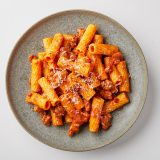Claudia Rinaldi cautioned me when I arrived at her apartment on the outskirts of Rome. “The first thing you need to know about pasta alla zozzona is what the word means,” she said. “It’s a Roman word for dirty.”
That didn’t deter me. Translate it as you like, I wanted it. In fact, I’d come to Italy almost entirely to learn how to make pasta alla zozzona, a dish until a few weeks before I’d never heard of.
But the descriptions I’d read sounded transcendent, a fusion of two of the region’s most important—not to mention best-known and most delicious—pasta dishes: pasta alla carbonara and pasta all’Amatriciana. So perhaps a pasta primer is in order.
Carbonara is a rich dish in which pasta is sauced with a mix of eggs, crisped guanciale (or sometimes pancetta), ample pecorino Romano cheese and plenty of black pepper. Amatriciana uses a similar formula, but replaces the eggs with tomatoes. Zozzona marries elements of both, and tosses in some Italian sausage for good measure.
“It’s a dirty mess of delicious stuff,” Rinaldi said.
Indeed. A more forgiving translation is leftovers, which also likely is an explanation of how the dish came to be. The bits and pieces of zozzona are Italian pantry staples, the sorts of things easily thrown together with pasta on any given weeknight.
Rinaldi blitzed through the recipe, browning sausage and pancetta while the pasta cooked, then adding tomatoes—canned are just fine, even in Italy—and simmering them down until thick. Eggs, cheese and pepper were next, all melding in the skillet. The result was rich, bright and deeply satisfying. I could have eaten many bowls of this.
Though wonderfully simple, it took learning the recipe a second time to identify the almost effortless techniques that elevate these common ingredients into something spectacular.
I was at Mamma Angelina, a family restaurant at the edge of the city. Chef/owner Andrea Dell’Omo doesn’t have zozzona on his menu, but he should. He offered to teach me his version and it easily was one of the best things I’ve eaten. Ever.
As he made it, three things stood out. First, he cooked his pasta in what seemed barely enough water. This is vital. People assume the creaminess of sauces such as this come from the cheese and eggs. And it does. But it also comes from the starch that leaches from the pasta into the cooking water, and that starchy water is a key ingredient in the sauce.
Second, he didn’t simply add tomatoes to the dish. He cooked them in the same skillet used to cook the sausage and guanciale. The juices deglazed the pan, pulling meaty richness into the sauce. And he cooked down the tomatoes, concentrating their sweet acidity to coat, rather than drip off, the pasta.
Finally, and most importantly, he knew when to crank up the heat (when browning the meats) and when to kill the flame (when adding the slurry of eggs, cheese, pepper and pasta water). Doing the latter over heat turns the mixture into scrambled eggs. I tasted versions from less talented cooks and trust me, scrambled egg pasta is not a good thing.
Call it dirty pasta. Call it leftover pasta. I don’t care. I’ll have another serving.
Carbonara Meets Amatriciana
In Rome, we learned the dirty secret to the best pasta
Photo: Joe Murphy; Styling: Wes Martin







